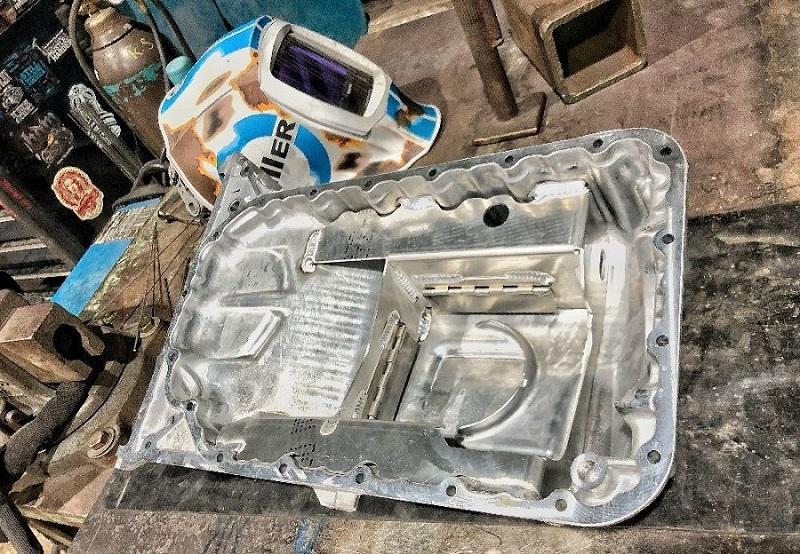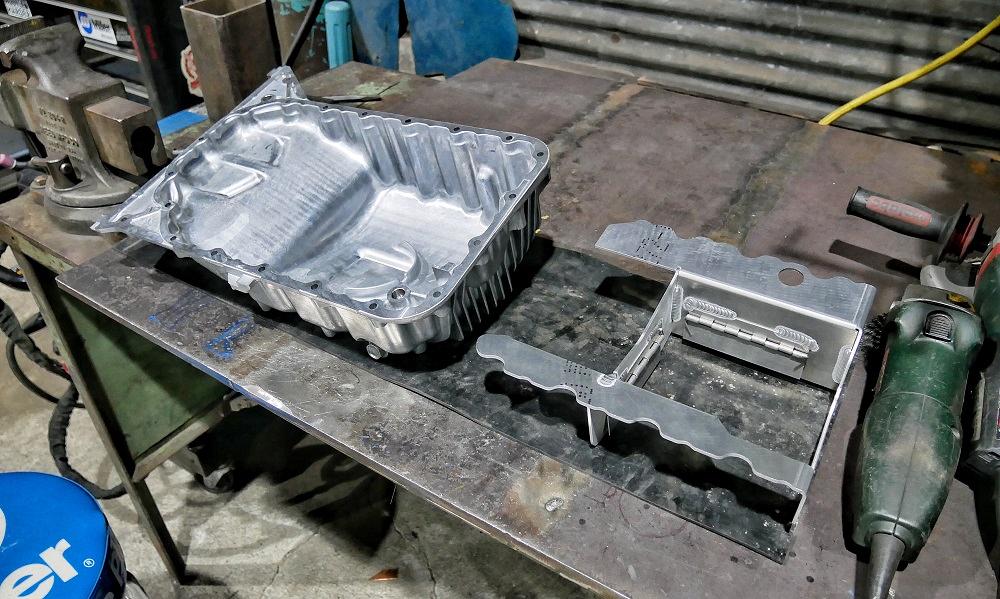Owner, Brown Dog Welding
- FMA
- The Fabricator
- FABTECH
- Canadian Metalworking
Categories
- Additive Manufacturing
- Aluminum Welding
- Arc Welding
- Assembly and Joining
- Automation and Robotics
- Bending and Forming
- Consumables
- Cutting and Weld Prep
- Electric Vehicles
- En Español
- Finishing
- Hydroforming
- Laser Cutting
- Laser Welding
- Machining
- Manufacturing Software
- Materials Handling
- Metals/Materials
- Oxyfuel Cutting
- Plasma Cutting
- Power Tools
- Punching and Other Holemaking
- Roll Forming
- Safety
- Sawing
- Shearing
- Shop Management
- Testing and Measuring
- Tube and Pipe Fabrication
- Tube and Pipe Production
- Waterjet Cutting
Industry Directory
Webcasts
Podcasts
FAB 40
Advertise
Subscribe
Account Login
Search
Fixing and ill-fitting aluminum baffle on a Honda S2000 oil pan
Aftermarket part not quite “made to fit” requires a simple aluminum weld
- By Josh Welton
- UPDATED August 7, 2023
- August 14, 2019

An aftermarket aluminum baffle and OEM oil pan for a Honda S2000 didn't quite fit together perfectly. But it was a quick fix with a clamp and weld. Photo provided by Josh Welton
As a gearhead, you get used to the idea that an aftermarket bolt-on part or even a weld-in piece billed as “made to fit” doesn't usually live up to its promise. As a matter of fact, when a part even comes close to lining up as it should, it’s a cause for celebration.
In the case of this aluminum baffle for a Honda S2000’s oil pan, we were closer to celebration than anger. My friend Marc Harris owns the car, and he’s building it piece by piece the right way as he sees it. And if there is anyone who understands “the right way,” it’s Marc. He’s an 82nd Airborne Division veteran who’s become a legendary automotive detailing savant. He’s done paint correction and ceramic coating on both my old Dodge Challenger Scat Pack Shaker and Dodge Demon.
Not only does he have the Detroit scene on lockdown with a backlog of Ford GTs, Porsche GT3s, Viper ACRs, and other low-volume, high-dollar cars, he gets flown around the country to work on exotics. Most people don’t realize that no matter what factory a vehicle comes out of, whether it’s Dodge or Ferrari or BMW, the car’s surface needs attention. They all have swirls in the paint, orange peel, etc., and once fixed they all need protective coatings. Marc has the eye for detail, patience, and work ethic needed to be at the top of this niche profession.
Not that I ever want to do a “lesser” job, but when you’re doing a project for someone whose work you respect, there’s that added bit of pressure to get things right.
Marc provided me with a brand-new OEM oil pan from Honda, and the aftermarket baffle from Moroso. The pan was nice and fresh, but it’s still cast. Sometimes new cast aluminum welds are worse than older “dirty” casts just because the quality of castings is all over the board now. Modern cost cuts can mean compromised metal with air pockets and dirt inclusions, which make welding a nightmare.
The Honda S200 Oil Pan Baffle
The baffle was a nice little fabricated piece made from 5052 aluminum. It mostly fit like it was supposed to. But the outside of a flapping door hit against part of the pan and one corner sat up about ⅜ inch instead of flat against the pan. Both were easy fixes. A quick touch with a sanding disc, and the door moved like it should. A C-clamp closed the gap at the corner, so I could weld it down.
The baffle isn’t structural at all, so it just needs to stay put. I did a little research and found that some people were having issues with their welds from the baffle to the pan cracking, so I was careful where I placed the welds and the length of the welds. As I tacked it in place, I massaged the baffle’s edges to fit tightly to the pan. This makes for an easier joint to weld and a stronger joint.
Now, I’m not gonna lie – I forgot if I used 4043 or 5356 filler. Each has its advantages and drawbacks. In this case, I wanted welds with more ductility, so I think I went with 5356. The only issue would be that 4043 is better for applications that are exposed to extended temps of 150 degrees or more. The pan definitely will get that hot, but not necessarily all of the time. I’ve seen fabricators do it both ways. I think for the baffle, I’d be safe with either.
The baffle and the pan welded nicely to each other. Obviously, a few of the joints were in hard-to-reach places, but the level of difficulty wasn’t too high.
I’d like to make note of one trick. I placed a rubber mat on my workbench to protect the pan from scratches and from marks that can be left when arcs jump from the table to the workpiece. Then, instead of attaching the ground directly to the pan, I used my metal third hand to close the circuit between the ground and the torch. This allowed me to rest the pan on a protective, nonconductive surface while maintaining the path for the arc.
And that’s that. A pretty simple project, but one where it still pays to think it through and pay attention to the details. I wouldn’t do it any other way, especially for Marc.
subscribe now

The Welder, formerly known as Practical Welding Today, is a showcase of the real people who make the products we use and work with every day. This magazine has served the welding community in North America well for more than 20 years.
start your free subscriptionAbout the Author

About the Publication
- Stay connected from anywhere

Easily access valuable industry resources now with full access to the digital edition of The Fabricator.

Easily access valuable industry resources now with full access to the digital edition of The Welder.

Easily access valuable industry resources now with full access to the digital edition of The Tube and Pipe Journal.
- Podcasting
- Podcast:
- The Fabricator Podcast
- Published:
- 04/16/2024
- Running Time:
- 63:29
In this episode of The Fabricator Podcast, Caleb Chamberlain, co-founder and CEO of OSH Cut, discusses his company’s...
- Industry Events
16th Annual Safety Conference
- April 30 - May 1, 2024
- Elgin,
Pipe and Tube Conference
- May 21 - 22, 2024
- Omaha, NE
World-Class Roll Forming Workshop
- June 5 - 6, 2024
- Louisville, KY
Advanced Laser Application Workshop
- June 25 - 27, 2024
- Novi, MI
































